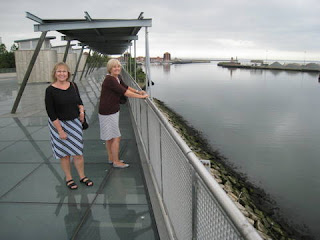We took the tube back to Queen's Park – 2 transfers and a horde of holiday makers and teens heading to the big festival in Notting Hill.

It was great to get back to Alice and Zach's – sans car – and relax for the evening.
Our International Adventures


It was quite grand in scale- but lacked the beauty of the Lowestoft church.
Back on the road with London in our headlights. Not sure what to expect, we made our way into London – with multiple maps in hand and keeping our eye on the road watching every sign. The British have an odd and very irritating habit of signing to places and not to cardinal directions. So, if you're on the A40 and want to go west, you need to know the towns that you're heading toward – and the towns on each successive sign may change. Add to that the cars with no compass! We did great until we missed the turn for the A5 and were suddenly trying to navigate the streets of London, hoping to find a street name that we recognized. We finally saw Dyer Street and figured out that we could make a few turns and find Brooksville Avenue. We arrived to an empty house – except for Lewis, their 2 year old black lab. John tormented him by talking to him through the mail slot. We waited and finally left a note on the door and headed for the local pub. We had no sooner gotten our first drink than we saw Alice and Zach walking down the street with their luggage. Their train had been delayed for 2 hours.
We had some drinks and dinner at the house and met Lewis, who had, with proper introductions, become our new best friend.


.jpg)









We dropped our bags at the Barns Hotel and drove to Stotfold to the Church of St. Mary the Virgin. Stotfold was the last home of the Spencer brothers before they migrated to the States and is the church where the brothers were christened. We found the church locked, but knocked on the door of the vicor and her husband was kind enough to open the church for us.
We were able to see the baptismal font of Gerard Spencer -








 We had another library Day in Sunderland. With 2 inches of rain and major wind gusts projected, it wasn’t such a bad day to spend in the library. But then- John decided that we should take an excursion – walking- to Holy Trinity church.
We had another library Day in Sunderland. With 2 inches of rain and major wind gusts projected, it wasn’t such a bad day to spend in the library. But then- John decided that we should take an excursion – walking- to Holy Trinity church.
We were a bit skeptical when Jean and Gordon suggested a vist to Beamish Open Air Museum – it sounded like a British Williamsburg or a Renaissance Festival with people dressed up in costume acting out their historical roles. We were very surprised to find a beautiful –and very large (300 acres) park set up to illustrate life in Northeast England between 1825 and 1913. Our first stop was in “the Town”, set up as a typical north eastern market town in the year’s leading up to WWI. Trolley cars shuttle you through the cobblestone streets, filled with shops and houses. Places like the local dentist take you into the world of early 1900 dentistry.
The large manor home farm shows life in a wealthy farming family in the early 1800’s. Next to the manor home is an operating railway, carrying tourists for a 1 km ride.

But the highlight for John was the recreation of the Northeastern pit from the early 1900’s. The cottages show how miners and their families lived. The school, from 1892, had three classrooms that could hold 200 children. 
Near the village was the Drift Mine. This mine opened in 1855 and was worked for 103 years before closing in 1958. We toured the Colliery Heapstead building- where the cages were drawn up from the shaft beneath it. The coal tubs were weighed before the coal was tipped onto the screens for sorting and loading.
We stopped at the local store, Sainbridges, for some groceries because that evening, Gordon was preparing his famous beef stroganoff! Mmmm!
 In the morning, we drove up the coast to Lindesfarne, the “Holy Island”. A causeway connects the island to the mainland of Northumberland so we had to check the tides, since the road is flooded twice a day.
In the morning, we drove up the coast to Lindesfarne, the “Holy Island”. A causeway connects the island to the mainland of Northumberland so we had to check the tides, since the road is flooded twice a day.


When we got back, we got the full tour of Sunderland – seeing the little burgh of Hylton where Jean grew up, stopping at the National Glass Museum with the very strange all glass ceiling- that you walk on. It doesn’t sound so bizarre, but the ceiling is several stories up and you can see clear through to the people having coffee in the café.
We coerced Jean and Gordon to take us to the pub where they first met- the Three Horse Shoe pub.
Then, we had to end the evening with a stop at one of their favorite local hangouts- the Chester Pub – with some great people watching.